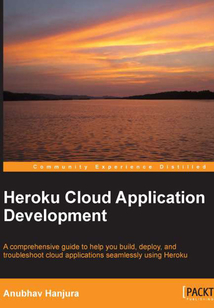舉報(bào) 

會(huì)員
Heroku Cloud Application Development
最新章節(jié):
Index
Aneasytofollow,handsonguidethatclearlyexplainsthevariouscomponentsoftheHerokuplatformandprovidesstepbystepguidanceaswellasnumerousexamplesonhowtobuildandtroubleshootrobustandscalableproductionreadywebapplicationsontheHerokuplatform.ThisbookisintendedforthosewhowanttolearnHerokutherightway.PerhapsyouarenewtoHerokuoraresomeonewhohasheardaboutHerokubuthavenotbuiltanythingsignificantwithit.Youshouldhaveknowledgeorfamiliaritywithcloudcomputingandbasicknowledgeofdatabaseandnetworkdeployment.
目錄(110章)
倒序
- coverpage
- Heroku Cloud Application Development
- Credits
- About the Author
- About the Reviewers
- www.PacktPub.com
- Support files eBooks discount offers and more
- Preface
- What this book covers
- What you need for this book
- Who this book is for
- Conventions
- Reader feedback
- Customer support
- Chapter 1. Hello Heroku
- What is cloud computing?
- Cloud service models
- What is cloud application development?
- Key advantages of cloud application development
- Introducing Heroku
- Walking down the memory lane
- An overview of Heroku's architecture
- The Heroku feature set
- Test driving Heroku
- Summary
- Chapter 2. Inside Heroku
- The Heroku platform stack
- Request routing in Heroku
- Heroku's logging infrastructure – the Logplex system
- The Heroku add-on architecture
- Programmatically consuming Heroku services
- The Heroku process architecture
- Running applications locally
- Setting local environment variables
- Process formation
- Running a one-off process
- Running anything
- Summary
- Chapter 3. Building Heroku Applications
- Heroku's guiding influence – the Twelve-Factor App methodology
- Creating a Heroku application
- Configuring your Heroku application
- Introducing buildpacks
- The slug compiler
- Summary
- Chapter 4. Deploying Heroku Applications
- Deployment on Heroku
- Getting a Heroku account
- Installing the toolbelt client kit
- Logging into the Heroku account
- Writing your application
- Pushing your application to Heroku
- The Git vocabulary
- Creating a Heroku remote
- Renaming an application
- Sending code to Heroku
- Optimizing slug size
- Cloning existing Heroku applications
- Forking an application
- Transferring Apps
- Optimizing deployments
- The choice of a region
- Tracking application changes
- Release management
- Summary
- Chapter 5. Running Heroku Applications
- The Heroku app lifecycle
- The Heroku CLI
- Running your cloud apps locally
- The Apps page
- Summary
- Chapter 6. Putting It All Together
- Heroku's support for Java
- Integrating Eclipse with Heroku
- Managing Heroku apps in Eclipse
- Summary
- Chapter 7. Heroku Best Practices
- The One Cloud development platform
- Heroku and the data store
- Creating a Heroku Postgres database
- Disaster recovery in Heroku PostgreSQL
- High availability Postgres
- When does Heroku Postgres failover?
- Configuring domains the right way
- Optimizing applications
- Managing your app dynos
- Using the Heroku scheduler
- Using NewRelic to keep the dyno alive
- Summary
- Chapter 8. Heroku Security
- Overview
- Communication between the developer's machine and the Heroku platform
- Application security tools
- Summary
- Chapter 9. Troubleshooting Heroku Applications
- The need for troubleshooting
- Your window to the running app – the logs
- Techniques for troubleshooting your app
- A recommended Heroku configuration
- Maintenance windows
- Error classification in Heroku
- Summary
- Chapter 10. Advanced Heroku Usage
- Experimenting with Heroku Labs
- Introducing Websockets
- Heroku and Websockets
- Your first Heroku Platform API call
- Sharing your app on Heroku
- Summary
- Index 更新時(shí)間:2021-08-20 17:55:25
推薦閱讀
- Linux網(wǎng)絡(luò)管理與配置(第2版)
- Windows Vista基礎(chǔ)與應(yīng)用精品教程
- 玩到極致 iPhone 4S完全攻略
- SharePoint 2013 應(yīng)用開(kāi)發(fā)實(shí)戰(zhàn)
- 直播系統(tǒng)開(kāi)發(fā):基于Nginx與Nginx-rtmp-module
- Social Data Visualization with HTML5 and JavaScript
- Linux基礎(chǔ)使用與案例
- Python UNIX和Linux系統(tǒng)管理指南
- Kali Linux高級(jí)滲透測(cè)試(原書(shū)第3版)
- Learn CUDA Programming
- μC/OS-III內(nèi)核實(shí)現(xiàn)與應(yīng)用開(kāi)發(fā)實(shí)戰(zhàn)指南:基于STM32
- OpenHarmony開(kāi)發(fā)與實(shí)踐:基于紅莓RK2206開(kāi)發(fā)板
- Learn OpenShift
- 操作系統(tǒng)之哲學(xué)原理第2版
- Docker容器技術(shù)與運(yùn)維
- OpenSolaris紅寶書(shū)
- UNIX傳奇:歷史與回憶
- Windows 10從入門(mén)到精通
- Windows 10應(yīng)用維護(hù)辦公大全
- 大規(guī)模分布式存儲(chǔ)系統(tǒng):原理解析與架構(gòu)實(shí)戰(zhàn)
- MacTalk·人生元編程
- React Native Blueprints
- Linux是怎樣工作的
- Mastering Bootstrap 4(Second Edition)
- 計(jì)算機(jī)應(yīng)用基礎(chǔ):Windows 7+Office 2010
- 蘋(píng)果電腦完全手冊(cè):OS X 10.8 Mountain Lion
- Linux Utilities Cookbook
- Concurrent Patterns and Best Practices
- 可伸縮架構(gòu)(第2版):云環(huán)境下的高可用與風(fēng)險(xiǎn)管理
- 鴻蒙應(yīng)用開(kāi)發(fā)入門(mén)

